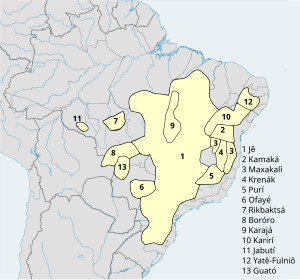Loading AI tools
Language family in Brazil From Wikipedia, the free encyclopedia
Macro-Jê (also spelled Macro-Gê) is a medium-sized language family in South America, mostly in Brazil but also in the Chiquitanía region in Santa Cruz, Bolivia, as well as (formerly) in small parts of Argentina and Paraguay. It is centered on the Jê language family, with most other branches currently being single languages due to recent extinctions.
| Macro-Jê | |
|---|---|
| Macro-Gê | |
| Geographic distribution | |
| Linguistic classification | Je–Tupi–Carib?
|
| Subdivisions | |
| Language codes | |
| Glottolog | nucl1710 (Nuclear–Macro–Je) |
 The Macro-Jê families of Kaufman's conception | |
The Macro-Jê family was first proposed in 1926, and has undergone moderate modifications since then. Kaufman (1990) finds the proposal "probable".[1]
Eduardo Ribeiro of the University of Chicago finds no evidence to classify Fulniô (Yatê) and Guató as Macro-Jê, pace Kaufman, nor Otí, pace Greenberg. Ribeiro does include Chiquitano, pace Rodrigues.[2]: 263–4
These languages share irregular morphology with the Tupi and Carib families, and Rodrigues (2000) and Ribeiro connect them all as a Je–Tupi–Carib family.
Pache (2018) suggests a distant genetic relationship between Macro-Jê and Chibchan.[3]
Glottolog accepts Jean, Krenak (Aimore), Karaja, Maxakalian, Ofaie, Rikbaktsa, and Yabutian (Jabuti). Lexical parallels with Kamakanan and Purian have yet to be corroborated with reconstructions; the similarities with Purian disappear once Coropo is reclassified as Maxakalian. It notes suggestive grammatical similarities with Bororoan, Kariri, and Chiquitano, of the kind also shared with Tupian and Cariban, but little lexical evidence.
Jolkesky (2016) proposes the following internal classification of Macro-Jê:[4]: 794–795
Nikulin (2020) proposes the following internal classification of Macro-Jê:[5]
Nikulin (2020) does not accept the following languages and language families as part of Macro-Jê.
However, Nikulin (2020) considers Chiquitano to be a sister of Macro-Jê.[5]
| Proto-Macro-Jê | |
|---|---|
| Reconstruction of | Macro-Jê languages |
| Lower-order reconstructions | |
Proto-Macro-Jê is notable for having relatively few consonants and a large vocalic inventory. There are also complex onsets with rhotics, as well as contrastive nasalization for vowels.
Phonological inventory of Proto-Macro-Jê as reconstructed by Nikulin (2020):[5]
For a list of Proto-Macro-Jê reconstructions by Nikulin (2020), see the corresponding Portuguese article.
Many Macro-Jê languages have been in contact with various languages of the Tupí-Guaraní family, which resulted in lexical borrowings. For instance, Ribeiro (2012) finds a number of Apyãwa loanwords in Karajá (such as bèhyra 'carrying basket', kòmỹdawyra 'andu beans', hãrara 'macaw (sp.)', tarawè 'parakeet (sp.)', txakohi 'Txakohi ceremonial mask', hyty 'garbage (Javaé dialect)') as well as several Karajá loans in Apyãwa (tãtã 'banana', tori 'White man', marara 'turtle stew', irãwore 'Irabure ceremonial mask'), Parakanã, and Asuriní of Trocará (sata 'banana', toria 'White man').[2]: 10–12 Loans from one of the Língua Geral varieties (Língua Geral Paulista or Língua Geral Amazônica) have been found in Karajá (jykyra 'salt', mỹkawa 'firearm', brùrè 'hoe', kòmỹta 'beans', mabèra 'paper (Xambioá dialect)', ĩtajuwa 'money (dated)'), Maxakalí (ãmãnex 'priest', tãyũmak 'money', kãmãnok 'horse', tapayõg 'Black man'), Ritual Maxakalí (kõnõmĩy 'boy', kõyãg 'woman', petup 'tobacco', pakõm 'banana', tapuux 'foreigner', xetukxeka 'potato'), and Krenak (tuŋ 'flea', krai 'non-Indigenous person, foreigner').[6] Chiquitano has borrowed extensively from an unidentified Tupí-Guaraní variety; one example is Chiquitano takones [takoˈnɛs] 'sugarcane', borrowed from a form close to Paraguayan Guaraní takuare'ẽ 'sugarcane'.[7]: 8
Some Macro-Jê languages from different branches have secondarily contacted with each other, also resulting in lexical loans. Ribeiro (2012), for instance, identifies several Karajá loans in Mẽbêngôkre, especially in the dialect spoken by the Xikrin group. These loans are thought to have entered Mẽbêngôkre from the variety spoken by the Xambioá group of the Karajá people. Examples include warikoko (Kayapó dialect) or watkoko (Xikrin dialect) 'tobacco pipe', rara 'kind of basket', wiwi 'song, chant', bikwa 'relative, friend', bero 'puba flour', borrowed from Karajá werikòkò, lala, wii, bikòwa, bèrò.[2]: 13
Loanwords from Brazilian Portuguese are found in many, if not all, Macro-Jê languages spoken in Brazil. Examples from Maxakalí include kapex 'coffee', komenok 'blanket', kapitõg 'captain', pẽyõg 'beans', mug 'bank', tenemiyam 'TV' (borrowed from Portuguese café, cobertor, capitão, feijão, banco, televisão);[6] in Karajá, Ribeiro (2012) documents the Portuguese loans nieru 'money' and maritò 'suit, jacket' (from dinheiro, paletó), among others.[2]: 18
There is a significant number of loanwords from Chiquitano or from an extinct variety close to Chiquitano in Camba Spanish, including bi 'genipa', masi 'squirrel', peni 'lizard', peta 'turtle, tortoise', jachi 'chicha leftover', jichi 'worm; jichi spirit', among many others.[7]
Jolkesky (2016) notes that there are lexical similarities with Arawakan languages due to contact.[4]
Seamless Wikipedia browsing. On steroids.
Every time you click a link to Wikipedia, Wiktionary or Wikiquote in your browser's search results, it will show the modern Wikiwand interface.
Wikiwand extension is a five stars, simple, with minimum permission required to keep your browsing private, safe and transparent.